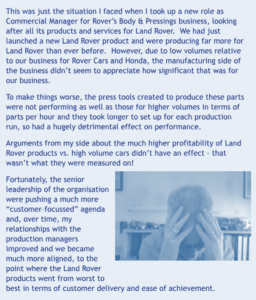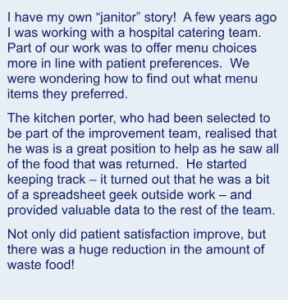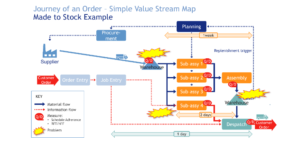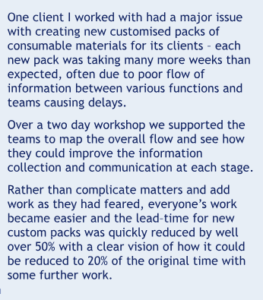Operations through customer focus. Could lack of customer orientation in Operations be the cause of poor performance? Is your belief in customer service failing to translate into results? Most business leaders know that a strong focus on providing a great service to customers makes good business sense. Sales increase as a result of good reputation, meaning that less effort is expended retaining customers and acquiring new ones. Not only that, but costs are reduced as less effort is expended correcting mistakes and compensating unhappy customers. This helps you to become more competitive in the market while simultaneously increasing margins and profits. However, experience shows that knowing this at senior level and having a strong service ethos in customer–facing functions doesn’t always deliver the hoped–for result. Deliveries of products and services can be late and/or have quality problems and costs remain stubbornly over budget. Eyes turn quickly to the operations side of the business and questions are asked. Don’t they realise how important this is? Don’t they care?
Table of Contents
ToggleDon’t the operations teams care?
Looking inside the organisation, There are some common symptoms:
- Instead of working together, there’s lots of infighting between departments. Sales blame Operations for poor performance. Operations blame Sales for poor information about customer requirements. Production blames Purchasing for lack of materials. And the list goes on.
- Departments seem to have differing agendas, each more focussed on hitting their internal performance targets than satisfying customers.
- Conversations are more about matters relating to the business than what matters to customers.

Pic. 1
This sort of siloed thinking is often the result of conflicting goals and measures set for or within each department. While the intentions are noble – for example, machine efficiency in manufacturing, lower prices in purchasing, more sales – the effect is that every department and team becomes focussed on what matters to them, even if it has an adverse impact on customer service. Everyone believes that they are doing the right thing for the business, yet the overall result is far from that. Everyone becomes frustrated, leading to increasing conflict between teams and more and more issues escalated to senior management for resolution. A true vicious spiral heading ever downwards. The above symptoms can be just as true of organisations that have embraced the ideas of creating a culture for operational excellence as for those still working in more “traditional” ways. Leaders can be modelling empowering behaviours; teams can be motivated and engaged to deliver high performance using all of the ideas from our previous articles. Yet, without mechanisms to ensure that everyone’s efforts are first and foremost aligned to satisfying customer requirements, the organisation will experience “local pockets” of high performance without that translating to improved service and bottom-line benefits. It doesn’t have to be this way!
What if . . . . . . ?
- everyone in the organisation did their job in such a way that their colleagues couldn’t fail?
- information or product passed on to next person fully met their requirements for carrying out their step?
- everyone was able to respond positively and quickly to customer requests?
- even when things go wrong, customers know they are cared for?
Customers will find such organisations easier and more pleasurable to deal with and, consequently, harder to leave. All of which will deliver the business benefits highlighted above.
The bones of a better way
The basics of creating a better way are remarkably simple, albeit it they may take some effort to change established thinking and behaviour. Put simply, every process in the business must be first and foremost aligned to the common goal of providing what the customer needs, when they need it. Every person needs to see their role as part of a system that serves the customer, very much like the legendary story of the janitor at NASA who, when asked by JFK what he was doing answered; “I’m helping to put a man on the moon!”

Pic.2
Operations – Connecting to Customers
In my very early days with Operational Excellence — back in the late 1980s when we were undertaking our Total Quality Management training — one of the most transformational ideas I was introduced to was that of identifying who my customers were and considering the impact of their requirements on what my job was and how I did it. This didn’t just mean the end customers for our products, in this case Rover cars and Land Rovers. After all, they seemed quite distant to my day-to-day work even though the idea of “working to make cars safer” felt like a noble purpose. No, what was more transformational was considering who my “internal customers” were. What information did they require and when? How would they use it? What did they think of how that was currently done? What improvements could they suggest? All of these were powerful questions that helped me to see my role in a new light. So helping everyone in the organisation make those connections between their role and both external and internal customers is really helpful to:
- Provide them with a very specific sense of purpose.
- Clarify their role and what is expected.
- Give a sense of pride in a job well done.
- Ensure that the requirements of the “end customers” of the organisation are met or exceeded.
Clarity of communication
A key starting point is that all organisational communications should continually reinforce the message of who we are to serve – customers, colleagues, shareholders and wider society, and why that matters. It must be clear that a service ethos is a foundational part of the company philosophy and values. It should appear in the vision and mission statements of the organisation.
Senior management commitment and modelling
Like everything else we’ve talked about in this series, creating a customer–centric culture starts from the top. If the but in the words and actions of senior leaders don’t match the printed statements, everyone else will get mixed messages about what really matters. There are some significant questions that should be asked:
- Do senior leaders talk more about satisfying customers than internal issues of shareholder value?
- What measures get most attention – customer service or efficiency, cost etc?
- What opportunities are created for everyone to understand the customer perspective – stories shared, opportunities to interact directly with the customer and so on?
A value stream focus
A great way to help everyone answer the question “how does what I do add value to our customers” is to focus more on what is commonly referred to as a “value stream” than individual departments’ tasks and functions. A typical value stream is the one from receipt of order to shipment of product to the customer. This requires the “flow” of material and information through the business.

Pic.4
Presenting this flow in a visual way is a powerful way to help everyone visualise their part. There are a number of methods that can be used, from a simple flow chart to a more comprehensive Value Stream Map as shown in the illustration. For each step in the process, identify the Outputs – product and information – required for the next stage(s) of the process and the Inputs necessary for this step to produce those outputs. Taking the idea of a customer–centric culture, the “owners” of the next stage(s) can be thought of as internal customers, so the Outputs will, in essence, be their required Inputs. Encouraging dialogue between the “owners” of each step will enable real understanding of the requirements and how well they are met, fostering good collaboration between teams towards a shared goal of satisfying the end customer. Done well, this value stream approach will align everyone’s efforts and establish a series of collaborative relationships to ensure that all customer requirements – internal and external – are met.

Pic.3
Goals and measures aligned
However much we might like to believe otherwise, goals and measures are significant drivers of behaviour, whether in ways that are helpful or unhelpful. A careful review of targets set and measures used is therefore an essential ingredient of realigning everyone’s thinking and behaviour. For example, in a production area, measures of quality and schedule adherence are an effective proxy for customer service (provided that the schedule is a good reflection of customer demand), so should be seen to be more important than measures of machine performance or productivity.

Pic.5
Ready for action?
Operations through customer focus. If you are experiencing any of the symptoms above, addressing them will surely be a priority. Our two–day Value Stream Alignment workshop is a proven way to get multi–disciplinary teams aligned to focus on identifying and satisfying customer needs in ways that promote harmony and effective collaboration between different teams. Facilitated on your premises or at another venue convenient to you and tailored to the specific requirements of your organisation, the workshop will enable your teams to explore their current process, align to a common goal and identify any “gaps” or misalignments in the process. The outcome will be a clear vision for a customer–focussed future that delivers better products and services more quickly and at lower cost. Not only that, but you’ll have a defined set of actions to bring it to reality, improve your presence in the marketplace and increase your profits.

Harvey Leach is passionate about helping organizations acquire the knowledge, skill, and culture they need to achieve Operational Excellence. Following a successful career in the automotive industry with Rover and BMW Group, where he worked in a variety of roles covering R&D, production and corporate strategy, Harvey has worked as a consultant, trainer, and coach since 2004. He delights in seeing teams “come alive” as they discover how they can apply the same principles that underpin some of the world’s leading companies to their organization to achieve impressive improvements in performance and more fulfilling lives.






